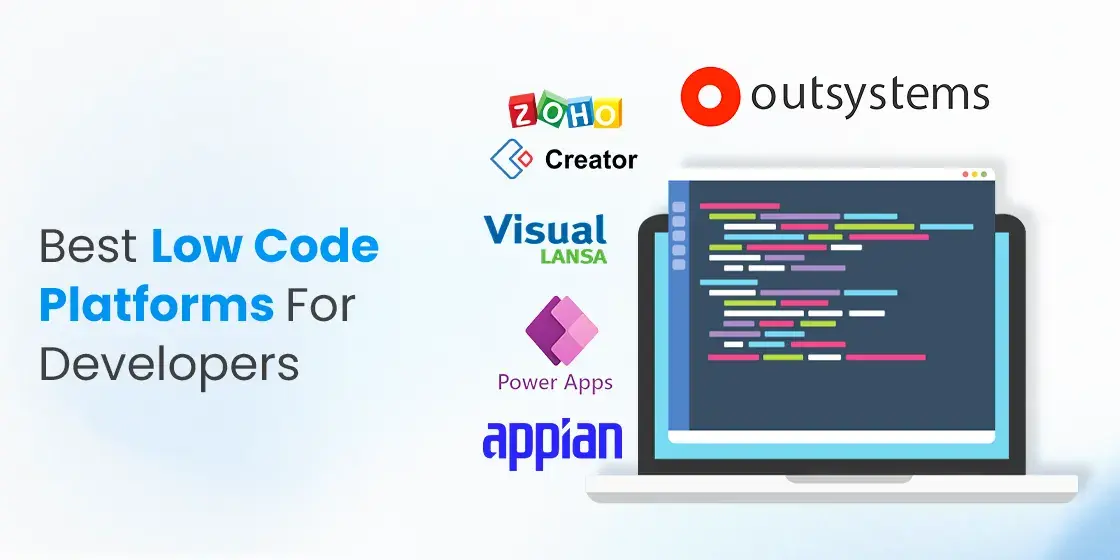Low-code applications offer significant benefits in terms of integration which is essential when creating applications that seamlessly connect to various systems and service. Here are some of the key benefits: Prebuilt Connectors & APIs
Wide Range of Connectors: Low-code platforms typically have a large library of connectors that are pre-built for common enterprise software (e.g., ERP, CRM and cloud services such as databases,). It simplifies the integration with these systems.
API Integration: A lot of platforms provide out-of-the-box API integration capabilities. This allows developers to quickly connect to external data and services.
Simple to Use:
Drag-and-Drop Interfaces: Several integration tasks can easily be accomplished using drag-and-drop interfaces. This makes it feasible for developers and other non-developers to build complex systems without extensive coding.
Visual Workflow Builders: Visual tools for designing workflows and data flows aid in understanding and establishing integrations with greater ease.
Standardized Integration Methods:
SOAP and RESTful Services : The support for web services standards such as REST and SOAP makes it easy to integrate with many other systems.
OData and other Standards: Support for standards such as OData enables easy access and manipulation of data on a variety of platforms and applications.
Real-Time Data Synchronization:
Real-Time Integrations: Lowcode platforms can manage data synchronization in real time between systems and applications, ensuring data is always updated and uniform throughout an organization.
Event-Driven Architecture: Some platforms feature architectural designs driven by events that allow applications to respond in real-time, to events which is essential to create interactive and dynamic applications.
Legacy System Integration:
Bridging Old Systems and new Systems Low-code platform often provides tools to integrate with existing older systems. This allows companies to modernize their IT Infrastructure without having to overhaul the existing systems.
Data Migration: Built-in tools allow you to transfer data from older applications to new ones that are built on platforms that use low-code.
Integration of Third-Party Services:
Cloud Services Integration: Easy scaling and deployment of applications is possible with seamless integration with cloud services like AWS, Azure and Google Cloud.
Business Applications Low-code platforms can be used to be integrated with different business apps like Salesforce, SAP or Microsoft Dynamics. They enable an integrated workflow for various business functions.
Data management simplified:
Data models that are unifying: A few platforms provide low-code support for unified data models to make data management easier across platforms.
Data Connectors are pre-configured data connectors which provide rapid access to sources of data and permit manipulation.
Security and Compliance
Secure Integrations: Low-code systems ensure that integrations adhere to security protocols and standards, assisting to protect data during transit and at rest.
Features for Compliance: These platforms come with features that guarantee integrations comply with regulatory requirements (e.g. GDPR, HIPAA), giving businesses who handle sensitive data security.
Extensibility:
Custom Codes and scripts. For more complex needs for integration, low-code platforms usually allows the use of custom scripts and code. This gives flexibility but without compromising user convenience.
Plug-in Ecosystems: An eco system of extensions and plugins allows users to expand the possibilities of integration. They can include additional features whenever they want.
Overall, the integration capabilities of low-code applications development platforms makes them a powerful instrument for developing connected, efficient, and scalable applications. They help connect different platforms. They also enhance data flow. Take a look at the best on front page on Low-code Platform for application development for blog info including develop web application, app modernisation, ms azure sql, develop web application, application modernization software, app development platform, azure sql databases, database in azure, ms azure sql, application modernisation and more.

The Benefits Of Low-Code Development For Governance And Security
Low-code development has several benefits regarding security and governance. These are crucial to ensure that apps are secure, reliable and properly managed throughout their lifecycle. These are the main benefits.
Unified management console: Low-code platforms typically have a central administration console from which administrators manage all applications and ensure that there is a consistent management within the organization.
Role-Based Access Control: These platforms include robust role-based control which allows administrators to set guidelines and enforce them. This permits only authorized users to alter or access specific elements of a program.
Compliance and Regulatory Application:
Many low-code platforms have built-in compliance features. They are built to conform to industry standards and regulations like GDPR or HIPAA. They offer tools and frameworks to ensure that the applications are compliant with these requirements.
Audit Trails and Logging: Comprehensive logging, audit trails and logs are usually integrated into companies, allowing them to track changes and monitor access. They can also ensure compliance of internal and outside regulations.
Additional Security Measures
Data Encryption Low-code systems typically include built-in encryption of data during transport and at rest, which protects sensitive information.
Security Certificates: Many low-code providers have a security certificate (e.g. ISO 27001 and SOC 2) which demonstrate their adherence to strict security standards. They offer an additional security level to their customers.
Automated security updates
Regular patches and updates Low-code platforms can handle the majority of security patches and updates in a way. They make sure that applications are protected from the latest threats without having developers intervene manually.
Security Monitoring: Continuous security monitoring tools are typically included, providing real-time alerts and insights into security risks that might be present.
Data Governance
Data Access Policies These platforms enable companies to establish data access rules and enforce the policies, making sure that data is only available to those who have been granted access. They also ensure the data is used correctly.
Data Masking and Anonymousization The tools built into the system to hide and anonymize data helps protect sensitive information in development and testing environments.
Consistent Lifecycle Management of Applications:
Pipelines for development and delivery: Low-code platform often include integrated pipelines for development and delivery pipelines that include security tests. Security is ensured throughout the entire lifecycle.
Version Control: Integrated version control helps manage changes and ensures that any modification to the application can be tracked and reverted if necessary, maintaining the integrity of the application.
User authentication:
Single Sign-On (SSO) Support for single sign-on as well as other advanced authentication mechanisms simplifies user management and enhances security.
Multi-Factor Authentication Most platforms come with built-in multi-factor authentication, providing an extra layer of security when accessing apps.
Policy Enforcement and Compliance Monitoring:
Policy Templates: Low code platforms usually have pre-defined templates for governance and security that allow organizations to quickly implement policies.
Compliance Monitoring Tool: These instruments offer continuous monitoring, reporting and analysis of compliance status. It is easier to identify possible issues and take proactive action.
Integrate into existing security infrastructures:
Seamless Integration: Low-code systems are designed to work with current security software and infrastructure, like identity management systems SIEM (Security Information and Event Management) solutions, and firewalls.
API Security: API features to protect data and ensure the integrity of applications are built into the API.
Best Practices and Training:
Guided Best Practices: Many platforms offer guidelines and best practices that can help non-developers adhere with security standards.
Certain low-code companies offer security training to help users build and maintain secure apps.
Overall, governance and application security features assure that applications are built and managed securely and in accordance with regulations and under control. These platforms are equipped with the tools, frameworks and regulatory compliance needed to secure sensitive data of customers, enforce policy, and maintain regulatory conformity and ease the oversight and management of the development process. Check out the top rated more helpful hints for more info including develop mobile application, driver jdbc, app dev platform, push notifications android, push notifications android, mobile app development platforms, develop mobile application, app modernisation, paas service, paas service and more.

Advantages Of Developing Applications Using Low-Code In Terms Of Limitations And Customization
Low-code application development offers an integrated approach that offers significant advantages in terms of addressing limitations and allowing for customization. These are the main advantages: Handling limitations
Overcoming Complexity:
Simplified Development: Low-code platform reduces the complexity of development by providing components and templates that are pre-built. This allows for faster creation and deployment.
Many platforms have automated workflows that help developers to navigate through complex processes. They decrease the chances of making mistakes and help maintain uniformity.
Scalability Solutions
Built-in Scalability: Low code platforms include many features that support an architectural design that is scalable, allowing applications to cope with increased load without significant redevelopment.
Performance Monitoring: The instruments which monitor and optimize performance help to make sure that applications run efficiently regardless of the fact that they are growing.
Security and Compliance
Integrated security features of Low-code come with built-in measures of security like encryption. Access control that is based on roles and automated compliance check to address the most prevalent security concerns.
Regular Updates: Platforms regularly change their security protocols as well as conformity measures, making sure that applications are protected against emerging threats.
Customization:
Extensibility:
Low-code platforms tend to integrate custom code, like JavaScript or Python that allow developers to enhance their capabilities beyond the limitations of normal.
Developers can design custom plugins and modules that add functionality tailored to specific business requirements.
APIs and Integration
API Support: Comprehensive support for APIs allows seamless integration with other systems and services. This allows for extensive customization and connectivity.
Third-Party Applications Lowcode platforms usually come pre-built with connectors for third-party apps, making it easier to integrate them and modify the app.
Flexible UX/UI:
Customizable User Interfaces: Designers can alter and design user interfaces that comply with the requirements for branding and usability and create a customized user experience.
Responsive Design Built-in features of responsive design guarantee that applications are able to be adapted to different screen sizes and devices.
Business Logic Customization:
Visual Workflow builders: These tools allow developers develop complex processes using little or no coding. They are able to design business processes and workflows visually.
Conditional Logic & scripting: Platforms allow for the application of conditional logic and custom scripting to manage specific business rules.
Data Management
Custom Data Modelling: Developers develop custom models to meet particular requirements of the application. They can customize the handling of data to meet business requirements.
Advanced Data Processing: Integration with the latest tools and capabilities for data processing allow customization in how the data is analysed, and used within your application.
Balancing limitations with customisation:
Frameworks and Standards:
Best Practices: Low-code platform encourages compliance with standards and industry best practices. This helps in maintaining high-quality apps that are scalable, secure and reliable.
Governance Frameworks Inbuilt governance frameworks will ensure that customizations do not interfere with the integrity, security or security of the software.
Feedback and Iterative Design
Rapid prototyping: Through being in a position to quickly prototype and test customizations developers can iterate on the feedback of users to enhance the app.
Continuous Improvement: Low-code platforms enable constant improvements. They can be modified and customized to meet the changing needs of business.
User Empowerment
Giving Citizen Developers the ability to be empowered In giving non-developers the ability to personalize their apps using easy-to-use interfaces as well as low-code platforms, they can increase the number of contributors who are able to improve and modify the application.
Training and Support Many platforms offer comprehensive training and support for users as they customize their applications, while not hindering its stability or performance.
Low-code software provides a scalable framework that can be tailored to meet your specific requirements. This balance allows companies to create and maintain applications that work and adapted to meet specific business requirements. All while maintaining high quality, security as well as scalability and standards.
